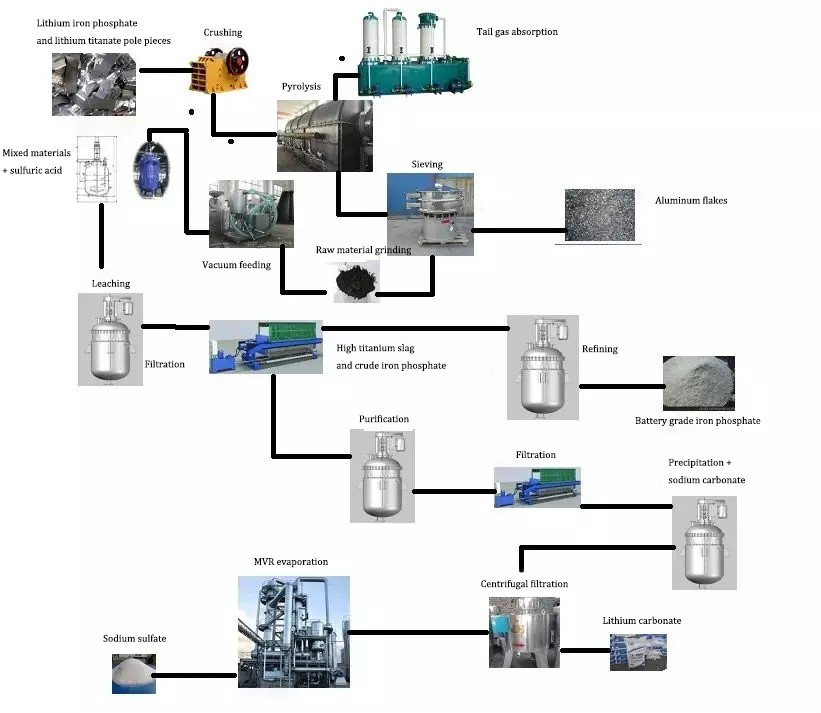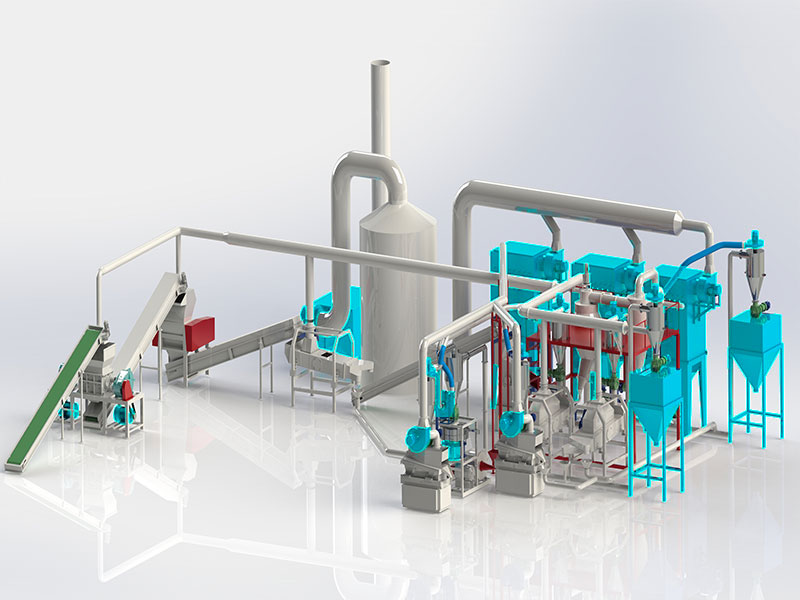close
Choose Your Site
Global
Social Media
ST2000
Starsplas
| Availability: | |
|---|---|
| Quantity: | |








Product Description

1、Raw materials (waste batteries): The waste batteries are transported to the shredder through the belt conveying and feeding device, and then entered into the shredder after being shredded, and the large pieces of crushed material are crushed for the second time. The crushed material enters the linear screening machine, and the lithium-cobalt powder that falls off during crushing is recovered and transported to ton bags for centralized collection; the mixed material of copper, aluminum and iron enters the magnetic separation for transportation to separate the iron shell. The remaining copper and aluminum materials enter the grinder again for grinding, and grind to 30-60 mesh particles. Then, the material enters the rotary vibrating screen for powder removal, and the lithium cobalt powder is transported to the ton bag for centralized collection. Copper and aluminum enter the gravity separation for copper and aluminum screening.
Multiple Security | 01."Multi-Seal" combined sealing technology. |
| 02.Real time monitoring of oxygen content, temperature, pressure and flame. Hazard elimination. | |
| 03.Initiate repair procedures in emergency situations. | |
| 04.Inert gas protection system. | |
| 05.Equipped with emergency explosion relief devices. | |
| 06.Equipped with emergency fire extinguishing devices. |
2. Dust removal equipment and deodorization equipment: The feed inlet of the shredder is provided with a dust removal pipe leading to the main dust removal pipe, and the crusher feed port is provided with a dust removal pipe leading to the main dust removal pipe. The dust and gas are collected from the linear screening machine, pulverization, conveyor, and vibrating screen collector, and then enter the cyclone dust collector-pulse dust collector-alkali washing neutralization tower in turn for dust collection and organic gas treatment.
| Technical parameter | |
| Equipment model | Design processing capacity |
| ST500 | 5000t/a |
| ST1000 | 10000t/a |
| ST1500 | 15000t/a |
| ST2000 | 20000t/a |
Our Lithium Battery Resource Recycling Equipment is designed with a variety of cutting-edge technologies and equipment to ensure efficient, sustainable, and safe recycling of lithium-ion batteries. Here's a detailed breakdow of the key components and processes:

Crushing Equipment
The first step in the recycling process is crushing, where large battery packs are reduced into smaller pieces. This is done using robust, high-performance crushers designed to handle the tough outer casings and materials inside lithium-ion batteries. Crushing enables better separation of valuable metals and materials in subsequent steps.
Shredding Equipment
After the batteries are crushed, shredders break them down further into smaller fragments. This process allows for the separation of different types of materials, such as plastics, metals, and electrodes. The shredding also helps to increase the surface area of the materials, improving the efficiency of subsequent processes.
Volatile Equipment
Volatile equipment, such as furnaces or specialized reactors, is used to safely deal with any volatile chemicals or gases released during the shredding or crushing stages. This equipment ensures that hazardous materials are properly handled, minimizing the risk of contamination or explosion, which is critical when working with lithium-ion batteries.
Sorting Equipment
Once the materials have been broken down into smaller pieces, a combination of sorting technologies—such as air classifiers, vibratory screens, magnetic separators, and flotation systems—are employed. These sorting systems segregate the different materials based on their physical and chemical properties, like weight, conductivity, and magnetism. For example, ferrous metals can be removed using magnets, while non-ferrous metals are sorted through other means.

Pyrolysis Equipment
The pyrolysis stage involves using high-temperature heating in an oxygen-free environment to break down organic materials, such as plastics and electrolytes, from the battery cells. This process not only removes unwanted contaminants but also helps recover valuable materials like carbon black, which can be reused in various industries.
Material Separation and Recovery
After pyrolysis, the remaining material is carefully analyzed and separated to recover precious metals such as lithium, cobalt, nickel, and copper. These metals can be refined and reused in the manufacturing of new batteries, contributing to a more sustainable, circular economy.
Advanced Monitoring and Safety Systems
To ensure the safe operation of the entire recycling line, our equipment is equipped with advanced monitoring systems that track temperature, pressure, and gas emissions at each stage. This ensures that the recycling process adheres to the highest safety standards and minimizes any environmental impact.
 Mexico Projects
Mexico Projects 
US Projects